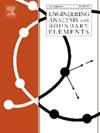多分辨率移动粒子法模拟自由表面流的体积补偿模型
IF 4.2
2区 工程技术
Q1 ENGINEERING, MULTIDISCIPLINARY
Engineering Analysis with Boundary Elements
Pub Date : 2025-02-01
DOI:10.1016/j.enganabound.2024.106080
引用次数: 0
摘要
本研究提出了一种用于多分辨率移动粒子法模拟自由表面流的新型体积补偿模型。建立体积补偿模型是为了在使用多分辨率粒子模拟自由表面流动时保护体积,而在以往的文献中很少讨论多分辨率模拟的这一主题。自由表面由线性多项式重构,因此可以轻松计算流体占据的体积。然后,自由表面上的粒子根据体积变化进行移动,以保持体积。在多分辨率模型中,颗粒大小能够根据其位置自适应地调整。在细化区域,大颗粒分裂成四个较小的子颗粒。靠近大颗粒的子颗粒会进一步合并成中等大小的颗粒,以避免子颗粒与母颗粒接触造成的不稳定。为了确保计算的准确性,采用了 LSMPS 框架。为了验证所开发的方法在使用多分辨率粒子时的能力,进行了一系列数值测试。本文章由计算机程序翻译,如有差异,请以英文原文为准。
A volume compensation model for multi-resolution moving particle method simulating free-surface flow
This study presents a novel volume compensation model for multi-resolution moving particle method simulating free surface flows. The volume-compensation model is developed to conserve volume when simulating free surface flow using multi-resolution particles, a topic that has been rarely discussed for multi-resolution simulations in previous literature. The free surface is reconstructed by a linear polynomial, enabling the volume of fluid occupied to be easily calculated. Then particles on the free surface are shifted according to the volume change to conserve volume. In the multi-resolution model, the particle size is capable of adapting in an adaptive manner in accordance with its position. In the refined area, the large particles split into four smaller child particles. Child particles near to the large particles are further merged into middle-size particle to avoid the instability caused by the contact of child particles and parent particles. In order to ensure the accuracy of the calculations, the LSMPS framework is employed. A series of numerical tests were conducted to validate the capability of the developed method using multi-resolution particles.
求助全文
通过发布文献求助,成功后即可免费获取论文全文。
去求助
来源期刊

Engineering Analysis with Boundary Elements
工程技术-工程:综合
CiteScore
5.50
自引率
18.20%
发文量
368
审稿时长
56 days
期刊介绍:
This journal is specifically dedicated to the dissemination of the latest developments of new engineering analysis techniques using boundary elements and other mesh reduction methods.
Boundary element (BEM) and mesh reduction methods (MRM) are very active areas of research with the techniques being applied to solve increasingly complex problems. The journal stresses the importance of these applications as well as their computational aspects, reliability and robustness.
The main criteria for publication will be the originality of the work being reported, its potential usefulness and applications of the methods to new fields.
In addition to regular issues, the journal publishes a series of special issues dealing with specific areas of current research.
The journal has, for many years, provided a channel of communication between academics and industrial researchers working in mesh reduction methods
Fields Covered:
• Boundary Element Methods (BEM)
• Mesh Reduction Methods (MRM)
• Meshless Methods
• Integral Equations
• Applications of BEM/MRM in Engineering
• Numerical Methods related to BEM/MRM
• Computational Techniques
• Combination of Different Methods
• Advanced Formulations.
 求助内容:
求助内容: 应助结果提醒方式:
应助结果提醒方式:


